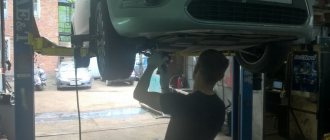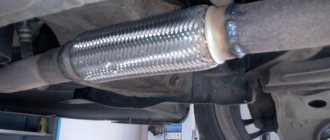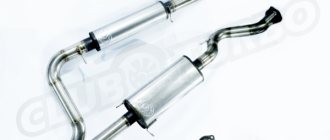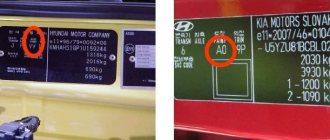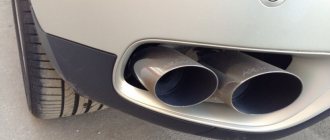Advantages of using cold welding to repair a muffler
Repair by cold welding is an excellent way to eliminate defects in exhaust structures; in addition, the part acquires additional qualities.
This material is a two-component adhesive that is used for metal surfaces. A number of advantages in use:
- Withstands mechanical, shock and vibration loads.
- Resistant to elevated temperatures (up to 150 degrees).
- Easy to use, allowing you to seal it yourself without using welding equipment.
- Availability.
- The strength of the connection is achieved in 5–10 minutes.
How to repair a muffler: materials and methods
Let's consider what materials are used for repairs, and in what cases each of them will prove to be better than others.
Bandage tape
Repairing a muffler without welding is a popular repair method that does not require a large investment of time and effort. In this case, a bandage tape is used, which is wrapped around the cylindrical parts of the body and exhaust pipes. Impregnated with high-temperature adhesives, the tapes withstand high temperatures and difficult operating conditions.
This option is not suitable when the hole sizes exceed a third of the part diameter. A bandage will be a temporary measure that will not solve the problem. You risk being left without a properly functioning muffler at any time, since tapes and analogues do not provide the necessary rigidity.
Sealants and putty
These are two more materials with which you can quickly restore the performance of the exhaust system. Special assembly sealants and high-temperature putties are available in car dealerships. They are used to seal small holes caused by mechanical wear. The main feature of silicate or ceramic based sealants and putties is that they are able to withstand high temperatures (up to 1000 °C inclusive).
Cold welding
The material has proven itself well where it is necessary to eliminate the effects of corrosion - another common problem with the exhaust system. On sale there are cold welding for metals, especially for cars and universal. The last two options will suit you. Cold welding is a two-part adhesive that gains strength after drying and withstands high temperatures and contact with chemically active substances.
Car owners love this material for its affordable price, easy use and the ability to repair any metal part in a matter of seconds. The main limitation is the scale of application. The material is only suitable for small cracks and other defects. It takes two days for cold welding to completely harden, and preparatory work takes no more than 10-15 minutes.
Welding
The most reliable but difficult way to restore a muffler. During welding, you can use bookmarks - this removes restrictions on the area of damage, as is the case with other repair materials. Welding also ensures the tightness and mechanical strength of the seams. It is recommended to perform the work with a semi-automatic welding machine. Additionally, you will need 1-2 mm thick sheet metal for patches, sanding tools and heat-resistant paint for the finishing coat.
Repair of corrugations and muffler pipes
Sometimes the problem of a non-functioning muffler lies in the pipes (straight or curved) that are used to remove exhaust gases. They burn out at bends and where they come into contact with hot gases, moisture, are exposed to high temperatures, etc. To restore pipes, the same methods are used as for a muffler (they are described above).
Repairing the muffler pipe is often not the only thing that needs to be done. Sometimes the problem of the exhaust system not working properly is caused by the corrugation that connects the pipe to the engine. It wears out a lot and it is better to replace it rather than restore it. If you are confident in the strength of the main part and do not plan to replace it in the near future, you will need the help of a specialist who will a) give a final assessment and b) suggest the optimal restoration method.
Muffler repair
It is better to entrust the restoration of any car part, even one that seems minor at first glance, to specialists. This will help avoid future operational problems and save time. Experienced service technicians will answer questions, perform diagnostics and repair work of any complexity.
To sign up, call the phone number listed on the website. We serve clients from St. Petersburg and the region by appointment daily from 10:00 to 23:00. You don’t have to search for components - the necessary spare parts are available in the service center or from our trusted suppliers. We guarantee a responsible approach, affordable prices and optimal deadlines for completing the work.
Flaws
Like any compositions, welding of this kind has the following disadvantages:
- This is a toxic material, so during use they wear PPE and the room is ventilated.
- Use after the expiration date is not allowed.
- It is necessary to select only those suitable for the welding plane, otherwise the process will be useless.
- Corrects minor damage to the exhaust structure. If the defect is large, it is better to resort to welding or contact special services.
Direct exhaust system
Crankcase ventilation valve
First, a little theory. So, what is the purpose of the exhaust system and how does it work? This question seems elementary only at first glance, and here’s why.
After all, the exhaust system performs many tasks simultaneously. The first of them is the removal of exhaust gases outside the vehicle. The second is to ensure improved filling of the combustion chamber with the air-fuel mixture.
Modern engines are designed so that the exhaust and intake phases overlap each other
Therefore, when both valves open, it is very important to ensure a vacuum behind the exhaust valve. After all, thanks to this “trick”, exhaust gases will leave the combustion chamber faster and make room for a new portion of the mixture
To achieve this effect, the law of inertia is used, which contributes to the uneven exit of exhaust gases from the cylinder. The whole thing happens due to the fact that when the exhaust valve closes, a zone of low pressure is created in the manifold itself, which at the same time moves through the muffler at the speed of sound.
However, if you install a barrier in the path of this flow, the sound will be reflected and end up at the exhaust valve at the moment when the latter opens. This is only possible if the distance to the obstacle and engine speed are accurately calculated. In automobile engines, this distance is large, and therefore the vacuum area from one combustion chamber returns to the engine at the moment when the other valve opens. The sound muffling effect is created by a tuned exhaust manifold (“spider”), which, with its connection of pipes, serves as an obstacle to the backflow wave.
The last, third function of the exhaust system is noise suppression. After all, no pipe or exhaust manifold can cope with such a task completely; a muffler is required. However, on racing cars you can find a system that consists almost without a muffler. In this case, there must be a turbine that provides “grinding” of the exhaust gas flow, thereby reducing the exhaust force, as well as smoothing out vibrations. Therefore, in order to reduce noise, a muffler is definitely necessary in such a situation.
How to use cold welding to repair a muffler
Before applying the material to the desired location, you should carefully prepare it: clean the surface from dirt with a metal brush or sandpaper. Then treat with a solvent that contains alcohol.
The mixture itself also requires preliminary preparation, since it consists of two components. They are mixed according to the instructions until smooth.
The composition is applied to the required place on the pipe using the patch method or as a welding seam. Then, to ensure the strongest possible connection, leave it to dry for a day.
We recommend watching the video:
For severe damage, after the mixture has completely dried, a tourniquet is used at the joint.
Which welding method is better to weld a muffler?
Repair of mufflers can be performed by two types of welding - cold and hot. Both have both advantages and disadvantages:
- Cold welding. It does not require special skills; if necessary, it can be used anywhere. In terms of its characteristics, it is slightly inferior to classical electric welding. Even a novice motorist can do it. To do this, the damaged part is cleaned with sandpaper and degreased. After this, the cold welding components are mixed until a thick creamy composition is obtained, which is applied to the damaged parts, after which they must be tightly compressed. The parts are allowed to stand for 1 hour, after which they are given the desired shape. The muffler can be subjected to full load a day after cold welding.
- Electric welding. More durable than cold, but you will need a garage to do it. In addition, the motorist needs a welding machine with a minimum current strength and a minimum electrode thickness. Repairs can be carried out in two ways. In any case, the surface must be cleaned of dirt and corrosion before starting work. If the breakdown is large, then you need to apply a metal patch and carefully weld it. When the holes are small, it is enough to weld them with an electric arc. In some cases, copper wire is used if the work is done using a semi-automatic machine.
After hot welding, the seam is carefully cleaned and the part is coated with heat-resistant paint or mastic.
How to choose cold welding
The variety of pasta choices makes buyers think about the right choice. Therefore, when choosing a composition, several points are taken into account:
- The maximum temperature that the seam will withstand. Since the muffler is constantly exposed to temperatures. The adhesive must withstand significantly higher temperature barriers. If the packaging indicates a temperature close to the temperature of the metal to which it is applied, then this product is not purchased.
- The composition includes a metal filler, which provides adhesion to metal.
- After drying, the material withstands mechanical damage and loads to which the exhaust structure is constantly exposed from the outside.
An example of such a structure is the welding of Abro Steel . Produced in the United States. This is where high-quality compounds are produced. It is used on various surfaces and provides high adhesion to any surface. The composition includes epoxy resins, which means that the mixture can withstand temperatures up to 204 degrees. The structure does not blur or change when interacting with liquids and oils. Adhesion is achieved after one hour, complete drying occurs after 24 hours.
Titan cold glue . It is sold in two containers in a single package. Before use, mix in proportions strictly according to instructions. The containers are presented in jars with lids, which is convenient for further storage. There is also a white Titanium mixture available, which comes in the form of a rod.
Withstands high temperatures over 200 degrees. Strength is achieved quickly. Once mixed, the mixture is used within five minutes. The first drying lasts 20 hours, the final drying after 24 hours.
Additional services
Upon completion of the repair, our service can measure the CO content in the exhaust gases and check the noise level of the exhaust system. If the malfunction is not caused by mechanical stress or corrosion, we will help the client identify the cause of the breakdown. Perhaps your fuel mixture formation is incorrectly set, or the exhaust valves are worn out. This will extend the life of the remanufactured muffler. Fast and high-quality repair of mufflers in JSC is a specialized service of GSAvto. The cost of restoration is significantly lower than replacing the exhaust with a new one. However, this does not affect the parameters of the car. And if you are the owner of a rare or discontinued foreign car, repair work is the only way to bring the muffler back to life.
If you need to repair the muffler on your car, come to the GSAvto car service at the address: Moscow, st. Kubinka, 3/10s3, (JSC, Kuntsevo and Mozhaisky districts, Molodezhnaya metro station, Kuntsevskaya metro station) and our specialists will carry out prompt repairs of the muffler and catalyst in the shortest possible time.
VAZ muffler design
A car muffler is a device that is designed to reduce the noise level, temperature and toxicity of combustion products. Today we will discuss the exhaust system of a VAZ car, and in this article we will provide answers to such common questions as:
- Design of VAZ car mufflers;
- Design features of a direct-flow muffler;
- How to replace the main and additional muffler of a VAZ.
basic information
The muffler of a VAZ car always receives increased attention, because its main task is to reduce the noise level, which is important. First, let's look at how the pre-muffler, or as it is also called the resonator, of a VAZ car works
A resonator is considered to be a medium type of muffler, which is located in the middle of the exhaust system. So, the pre-muffler consists of the following main elements:
- Throttle;
- Frame;
- Blind barrier;
- Thermal insulation;
- Perforated tube.
Now let's look at the design of this part of the transport:
- Frame;
- Rear barrier;
- Middle obstacle;
- Front perforated tube;
- Rear perforated tube;
- Inlet pipe;
- Exhaust pipe.
VAZ muffler design
What are the design features of a direct-flow muffler? The main element of this type of muffler is a perforated tube. With the help of perforation, the combustion products that enter the muffler expand quite effectively in its body. Thanks to these actions, the removal of combustion products is accelerated
It is worth paying attention to the fact that high-quality tuning can account for more than eighty percent of a straight tube. This means that when using the presented type of muffler, the level of exhaust system resistance will be about ten percent, and this is much more than without it.
Independent replacement of the main and additional muffler
The exhaust system of every vehicle regularly suffers from the accumulation of dirt, dust, moisture, corrosive and hot gases, as well as impacts. Moreover, applying patches to through holes will help solve the problem only for a certain period of time, and in the end, one way or another, a complete replacement will have to be made.
The exhaust system of a VAZ car can be subject to such main factors of destruction as:
- Heating the structure to high temperatures;
- Internal corrosion;
- External corrosion;
- Beats;
- Various damages and deformations;
- Constant vibration;
- Frequent changes in temperature conditions, from the heating process to rapid cooling;
- There are no effective means of protecting metal structural elements;
- Pollution;
- The influence of abrasive particles falling from the roadway;
The most vulnerable point of the exhaust system, which requires regular monitoring, is the muffler. Let's try to figure out how to replace the main muffler. The main signs that indicate the need to replace the housing of this device:
- Areas of through corrosion;
- Pipe fractures;
- Fractures of the hull;
- Deformation.
The main muffler is attached to the bottom of the vehicle using brackets and hanging rubber bands, and it is attached to the resonator pipe by fastening two parts of the clamps with bolts that tighten the flared ends.
So, the replacement algorithm:
- Unscrew the bolts that hold the clamp halves together;
- Remove the graphite O-rings;
- Remove the part from the hanging rubber bands. If such a need arises, you need to replace the hanging rubber bands.
- Hang a new one;
- Install a graphite seal at the junction of the pipes;
- Put on the clamp;
- Tighten the clamp halves using bolts.
Now we move on to considering the replacement of the additional muffler. Additional mufflers are not attached to the underbody of the vehicle. They are connected to the inlet pipes using clamps.
So, the replacement algorithm:
- Remove the main muffler;
- Loosen the clamp nut slightly;
- Using a screwdriver, spread the clamp and move it along the tube;
- Unscrew and remove them from the drain manifold tube.
DIY repair instructions
If you still decide to repair it, for example, there is no money for a new one, then follow my instructions:
1) Remove the burnt part. The process is not difficult, except for removing the pants (the part of the muffler that connects directly to the engine), where you will have to tinker a little with the fastening. It is also worth looking at the bolts; over time they can become very sticky, so it is advisable to use silicone lubricants to help with dismantling.
2) After removal, we determine the essence of the problem; it could be a burnt hole in the resonator! The pipes themselves, as a rule, rarely burn out. You also need to decide whether it is worth repairing this muffler link; often the walls that remain on the sides are also already thin, and if you weld to them, they will be a weak link.
3) It also happens that there are no holes on the surface, but the muffler still roars. Most likely, you replaced it with a similar one that fits your car, but the resonator, made in a homemade way, is not located correctly in it. Repair here will be complicated, because you need to open the top part, cut it off with a grinder, and then remake the resonator! BUT - you need to know how to position it correctly, which is also important, otherwise all the repair work will come to nothing.
4) We return to the burnt holes. Of course, many put them on cold welding, but as I wrote above, this does not last long, such repairs should be temporary in order, say, to get to the desired destination. Some people cover the hole with fiberglass cloth and epoxy resin; if you properly prepare the area and apply it according to the instructions, such repairs can last a long time. As practice shows, several thousand, and maybe tens of thousands of kilometers. The big advantage of such repairs is that you can do everything yourself. Let's watch a short video - instructions without welding.
5) We clean the places for welding, it is necessary to make sure that the contact is as strong as possible. Then a sheet of steel is taken and welded over the holes, thus we restore the tightness of the resonator or pipe.
As you can see, the muffler can be repaired in various ways. Some are truly DIY - cold welding, fiberglass + epoxy resin. They are sold in almost every construction supermarket. Also, the repair can be more serious - welding, so you can extend the life of the unit by many more kilometers.
Video of repair using welding.
That's all, before throwing this part away, see if it can be restored. That's all, read our AUTOBLOG.
Similar news
- Types of turbines. What kind are on the car, what to choose
- How often should you change the fuel filter? Let's look at a separate variant...
- How to remove the bumper of a Hyundai Solaris. Let's disassemble the front part, photo...
Add a comment Cancel reply
Exhaust system design
In general, the design of the exhaust system, corresponding, so to speak, to an average car, is shown below in the figure. It is named so for one reason - the design of the exhaust system for different cars can vary greatly. If for old cars an ordinary muffler was enough, then several new, rather specific elements appear in the design of a modern car.
The purpose of the latter is to convert toxic gases coming from the internal combustion engine cylinders into relatively harmless ones. The next element of the exhaust system, the resonator, has a completely different purpose. It serves to reduce noise and temperature of exhaust gases. The last element that is equipped with the exhaust gas removal system, and the presence of which is mandatory, will be a muffler.
This is a simplified diagram of exhaust gas removal for a regular car. However, depending on the brand of car, manufacturer, and age of the vehicle, the specific design may differ. So, the system may include two catalysts or an element such as a lambda probe may be present. Therefore, it makes sense to consider in more detail the individual components of the system and touch a little on its individual components.
Catalyst device
This is a special device that serves to reduce toxic substances in exhaust gases. Inside the catalyst, which is a metal body, there is a ceramic block, inside of which there are many thin channels coated with a layer of platinum with the addition of rare metals - rhodium, iridium and palladium. Another type of catalyst is a metal strip catalyst. This design is used to ensure that the contact area between metal and exhaust gases is larger.
Flame arrestor device
In many cases, when such high requirements are not imposed on the composition of exhaust gases, for example, in our country, it is practiced to use a flame arrester instead of a catalyst, which turns out to be much cheaper. In fact, this is a kind of resonator design, the purpose of the flame arrester is the primary breakdown of the gas flow from the cylinders, as well as reducing their energy and temperature. We must be aware that it will not be able to oxidize unburned fuel and will not reduce the content of toxic substances in the exhaust gases. However, it is much cheaper than a catalyst and ensures normal engine operation.
Muffler
There are two types of muffler:
- active;
- reactive.
Regardless of the type of muffler, its main purpose is to reduce noise levels. In active ones, noise is reduced by the use of sound-absorbing material. The disadvantage of such a muffler is coking of the internal filling.
Welding work
The most reliable way to eliminate such faults is welding. Thanks to welding, it is possible to carry out long-term repairs of exhaust system parts. Welding will ensure complete sealing of all seams and joints, and you will forget about repairing the muffler for a long time.
Resonator
The resonator is precisely the part that distinguishes a direct-flow gas removal device from a classic one. More specifically, direct-flow devices do not have a resonator as such. In the case of tuning, this allows you to achieve more power during operation, as well as make the engine noise louder and more impressive.
The resonator looks like a submarine from the inside: the ellipsoid consists of several compartments divided by thick metal walls. None of the walls, except the two extreme ones, are solid. Each of them has a hole into which a short tube is inserted. Each tube, in turn, has a large number of small holes on the walls.
From the exhaust manifold, gases enter the first compartment of the resonator. Then the gas hits the wall of the first compartment and begins to look for a way out. Leaking through a hole in the form of a tube, noise waves and vibrations are partially damped. The holes in the walls of the tube are designed to ensure that the gases are more evenly dispersed in the second compartment and also partially lose their energy.
Passing through several compartments, the gases practically do not fluctuate. This allows you to reduce their noise several times. In addition, modern systems often use so-called catalysts, which make the gas less toxic and reduce its harm to the environment.
Muffler noise neutralizer
A muffler has a lot of work to do, but what it does best is control noise. To muffle the sound of the exhaust not in principle, but of a specific engine, a certain model, with a certain volume and a certain number of cylinders, there cannot be a universal muffler. Each engine creates its own individual vibrations, which we perceive as noise. Sounds of different frequencies and different amplitudes are absorbed by the walls of several resonator chambers located in the path of the exhaust gas.
The noisiest place in a car is the internal combustion engine.
He has to go through a lot of holes, bounce off walls hundreds of times and change direction before breaking out. During this throwing of gas through the exhaust pipe, active heat generation occurs, but this is not the most difficult thing in the development of exhaust systems. Internal vibrations of any range, high-frequency, low-frequency, mid-frequency, at certain engine speeds, require you to adapt to them.
The geometry of the exhaust system is one of the most important factors in the fight against noise. The simplest example is shown by the simplest muffler of a T 74 tractor or a two-stroke T 25. The length of the entire exhaust system is no more than a meter, it consists of a short exhaust pipe, an exhaust manifold and a simple resonator. The effectiveness of such a system is very questionable, since the geometry of the muffler practically does not create interference and does not dampen resonant frequencies. Also, the noise level of the internal combustion engine is affected by the diameter and number of holes through which the exhaust gas passes. The more complex the geometry of the system and the more holes and bends it has, the more effectively noise waves are damped. Only in this case a certain contradiction arises - each additional obstacle to gases leads to a deterioration in the purging of the cylinders and, as a consequence, to a deterioration in their filling with the fuel-air mixture. Now we come close to the question of how the volume and complexity of the exhaust system reduces engine power.
It has been experimentally established that the volume of the exhaust system should be 5-7 times greater than the working volume of the engine. Only in this case can the system provide noise protection. But when developing exhaust systems, the spectral analysis of sound vibrations is also taken into account, which each car model has an individual and generalized approach to this issue cannot be. The effect of noise on the human body is also different - low-frequency noise up to 250 Hz contributes to driver fatigue and a rapid decrease in performance and reaction time.
Where to repair?
To repair a muffler yourself, you need welding equipment, and very high quality one at that. Therefore, for repairs, you should find a car service with good technical equipment, and do not try to revive the muffler with your own hands. It is better if the auto repair shop is specialized, that is, professionally engaged only in this type of work. In such services, as a rule, the craftsmen have good experience and perform their work quickly and competently. By contacting a specialized auto repair center, you will receive guarantees and you will not have to worry about the quality of repairs.
How does a car muffler work?
Car muffler device
The exhaust gases first pass through a resonator, where their speed and noise level are reduced.
Exhaust gases move through the exhaust system under high pressure, and their movement is accompanied by a sound wave that moves faster than the gases. The muffler consists of tubes of various diameters that are not connected to each other, and a steel mesh and sound-absorbing material are installed in the muffler body. Mostly fiberglass is used as such material. When moving, exhaust gases first pass through a resonator, in which their speed and, consequently, the noise level are reduced. Then they move to the main muffler, where they pass through a system of tubes in which the final reduction in speed and noise still occurs. Cars are equipped with a different number of mufflers: from 2 to 5.
What diameter to choose
The parameters of gas exhaust systems depend on the volume of air processed by the engine. The volume of air depends on the power and displacement of the engine. Based on this information, approximate pipe sizes can be recommended.
For example, for a 1.6 liter engine, exhaust pipes with a diameter of 3.8-5 cm are installed. For a 2.5 liter engine, structures measuring 5 - 6.4 cm are sufficient. For larger engines, structures measuring 7.6 cm can be installed. If Engine capacity above 2.5 liters, it is better to spend money on a dual gas exhaust system. As is obvious, the higher the engine displacement, the larger the pipe size should be.
In order to determine the size of the exhaust structure in a dual system, you need to divide the engine volume by two, and then make the calculation in accordance with the rules given above. For example, a 3-liter engine is equipped with two exhaust structures of 3.8 and 5 cm, a 5-liter engine is equipped with designs of 5 cm and 6.4 cm.
These parameters mean the same size throughout the entire exhaust structure (including the muffler). Theoretically, the muffler and exhaust structure can be made larger, but this will not affect the power, but will make the sounds lower.
Additional recommendations
The power ratings are also affected by the shape of the collector. It is better to purchase modified manifolds. They provide the best results. A conventional gas venting system can be improved by running a grinding wheel attached to a drill along the inner surface. You can also make the system from stainless steel. This also helps improve performance.
If the diameter of the pipes is too large, the movement of gases will decrease. Catalysts have the same effect. However, if you can replace the old design with a new one with normal dimensions, then the catalyst cannot be removed, since it is a mandatory part of the car. You can see the types of exhaust structures and various systems for cars in the photo.
Burnt out - what to do?
There are two solutions to the problem, this is the actual replacement (preferably with an original, or a spare part close to the original), or try to repair this failed link. Usually it is simply removed and welded; previously, “cold welding” was also used, but its use is limited in time; after a thousand, or maybe several hundred kilometers, the sound will appear again.
In general, if you decide to repair it yourself, then it is advisable to weld the hole, then under normal circumstances, this part of the muffler will cover several tens of thousands of kilometers.



